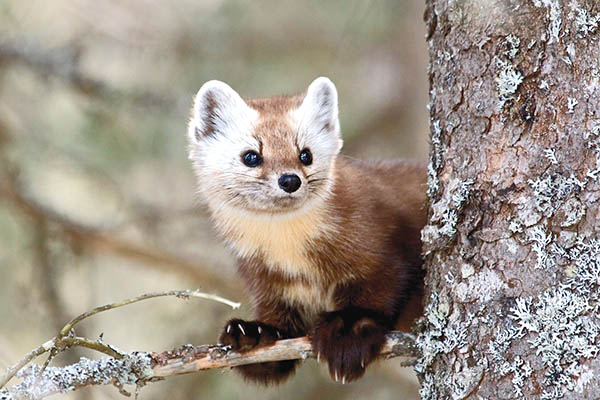After reading the title of my story, some people may be asking, “So who are the Martens”? It’s not who are the Martens but rather what are martens? Martens are actually members of the family Mustelidae which includes other fur-bearing animals like weasels, fishers, wolverines, badgers, skunks, and otters.
Most likely, the reason many people don’t know much, if anything, about martens, is that they have been absent from the state of Pennsylvania since the early 20th century. The reason for their disappearance was largely due to unregulated trapping and deforestation.
A marten, sometimes referred to as a pine marten, may reach a length of a foot and one-half to around two feet, including the tail. The marten has relatively large, somewhat rounded ears and a bushy tail. Its overall color can range from pale yellowish to dark brown to almost black. One key identifying factor is the light orange to yellowish patch in the front of the throat. In addition to the light patch on the throat, the marten is smaller than a fisher, so misidentification should not be a problem.
Of course, don’t expect to see one around here — at least not yet. The Bureau of Wildlife Management recently conducted a “feasibility study” to examine the possibility of reintroducing martens to certain parts of Pennsylvania. The study looked at several factors, including the martens’ interaction with other animal species and a look at public opinion regarding reintroduction. At a recent July meeting, it appears the Game Commission is planning to move ahead on the reintroduction.
Reintroducing wildlife to Pennsylvania’s countryside is nothing new; other successful reintroductions over the years have included bald eagles, river otters, beavers, bobcats, and most recently, the fisher. Reintroductions don’t always get a great reception from some. There were some who thought the fisher would devastate the wild turkey population because fishers are extremely agile at tree climbing. However, actual studies of stomach contents from trapped and road-killed fishers revealed that a very tiny percentage of turkeys were actually eaten.
So what do martens eat? Martens are omnivores; that is, they eat both plants and animals. A big part of their diet is squirrels and especially red squirrels. They also eat voles, mice, chipmunks, some birds, frogs, fish, insects, plant seeds, nuts — especially beechnuts — berries, fruits, and even carrion. Red squirrels are undoubtedly high on the menu since red squirrels often prefer coniferous forests, and so do martens. In fact, martens are mostly found to the north in much of Canada, Alaska, and the forested areas of our northwest. As some of our forests mature, more suitable habitats may be available, especially in the northern portion of the state.
Martens are just as capable in trees as they are on the ground. They are generally active all year round. They do not hibernate, but in extreme cold, they may enter into a shallow torpor state to preserve body temperature.
On occasion, I have people ask me what that big dark brown animal is that looks like an oversize mink that crossed the road; no doubt it was a fisher. In the not-too-distant future, we may ask about a similar critter crossing the road or running up a tree-check for the light patch on the throat.




